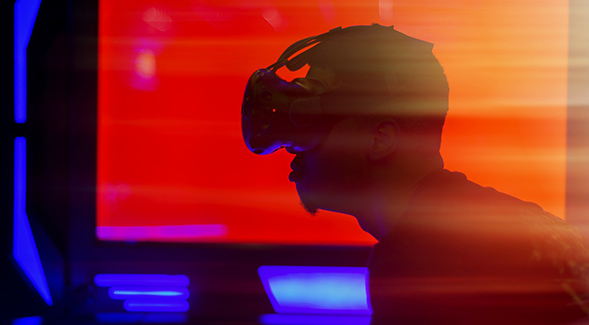Creating a Virtual Theater Experience
SDSU lecturer Sam Shpigelman is working with the latest cutting-edge technology in virtual reality and motion capture to mimic a full stage theater production.

“We can create action scenes without putting our actors into danger and build visual effects in virtual environments that achieve things that cannot be done easily in the real world.”
The world of performing arts is among many industries hit hard by the COVID-19 global pandemic. Ongoing projects and productions suddenly came to a halt as theaters and studios were forced to close down.
Amid these challenging times, Sam Shpigelman, a lecturer in San Diego State University’s School of Theatre, Television, and Film, found a way to adapt by using cutting-edge technologies to bring shows to life in a digital format.
Shpigelman is currently working with several students to explore the new technologies — 3D animation and visualization, virtual reality and gaming — that can be utilized to facilitate virtual performances in this time of social distancing.
“The industry is going in that direction, but it doesn’t necessarily mean the virtual art is going to replace real art in the long run,” Shpigelman said. “I am positive that live performing arts will always be there because people want to see and be involved in live events.”
Shpigelman has found there are a few different ways to bring performances to life without ever having an actor set foot on a physical stage. The first is actors and actresses recording themselves delivering their performance in front of a green screen in their homes. The footage of their performance can then be placed onto an entirely computer-generated stage, complete with other actors and set pieces.
The second method Shpigelman is exploring is the use of motion capture technology to create digital avatars that mimic actors’ movements on stage. Actors don a motion capture suit that tracks their movements and gestures as they deliver their performance. That information would then be used to drive the performance of a digital avatar of the actor that could move around the computer-generated stage.
Shpigelman said the capabilities this technology offers could be of great public interest since people do not now have access to performing arts centers. The virtual experience is not only an alternative to live performance but an opportunity to invite more people to interact with the virtual art it creates and may pave the way for future technologies and art forms.
In addition to making performances more accessible to audiences, these digitized performances allow more freedom in terms of set design. A set piece that would normally take several hours and hundreds of dollars to build can be inserted into a scene with a few clicks. Intricate costumes and makeup can be placed on the digital actors in seconds.
“We can create action scenes without putting our actors into danger and build visual effects in virtual environments that achieve things that cannot be done easily in the real world,” Shpigelman said.
Currently, Shpigelman is working on the virtual stage production of "Two Lakes, Two Rivers," scheduled for this fall and directed by Dani Bedau. In the fall, Shpigelman will also work with professor Randy Reinholz on an experimental piece that will utilize both green screen and motion capture technologies.



